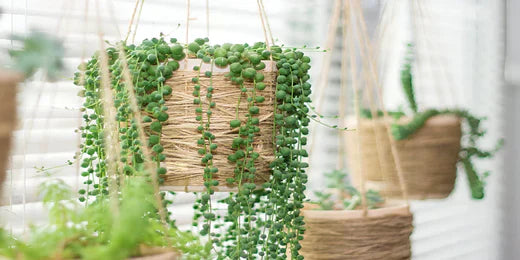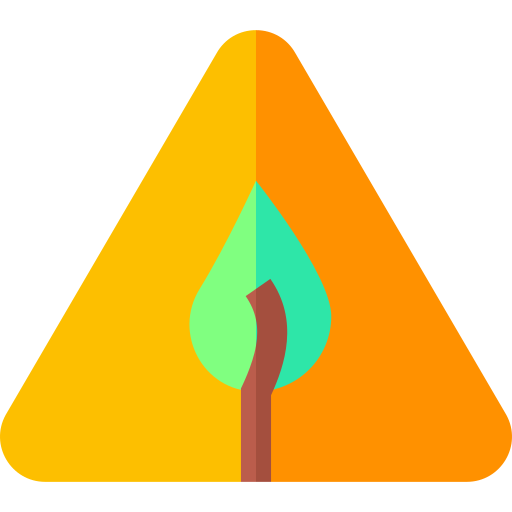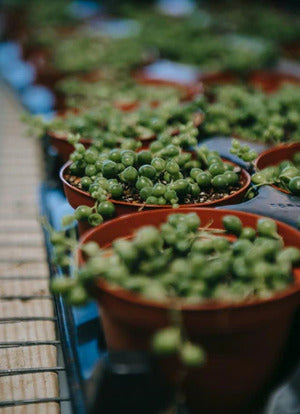String of Pearls Plant 'Care and Growing Guide' - Everything You Need to Know!
Updated: June 03, 2025

String of Pearls is not just a jewelry term; it's also the name of the most popular hanging succulent plant that can bring a touch of elegance to your living space. With its unique bead-like leaves hanging gracefully like a string of pearls, this plant is a favorite among plant enthusiasts looking to add a dash of charm to their indoor gardens.
About the Popular Hanging String of Pearls Plant
The String of Pearls plant is the most popular hanging succulent among the Curio genus. These are typically cultivated as a hanging plant around the world, but in their natural desert habitat in East Africa, they are terrestrial and form a ground cover.
It has cool and unique pea-shaped leaves that make it easy to spot and identify. Those pea-like beads start to cascade down from a hanging basket or spill over the edges of a pot, resembling a string of rubies; it's a sight to behold. The String of Pearls succulent has other common names, such as string of beads and string of peas.
The string of pearls produces white flowers throughout the spring. Additionally, this summer-dormant houseplant is hardy in zones 9 to 12. This East African native plant, known for its long, robust-thick cascading stems and fast growth rate, can reach up to 2 feet long at an average of 15 inches per year.
Nature's Little Pearls: They are so Unique & Special

- The String of Pearls Senecio rowleyanus has spherical leaves that resemble small peas, which hold water and are ideal for arid conditions. Not only are a string of pearl plants visually appealing, but they also serve a practical purpose.
- The round-shaped leaves minimize water loss through evaporation, making it an ideal adaptation for desert-dwelling plants.
- They have a cool little translucent window in their round leaves that allows light to enter the leaf and reach the chloroplasts, which are responsible for photosynthesis. Despite their compact, small size, the leaves absorb sunlight efficiently, converting it into energy.
- The pearls plant can tolerate low light conditions, preferring bright, indirect light, making it a versatile plant suitable for various home or office spaces.
Here at Planet Desert, you can learn how to grow, propagate, and care for the String of Pearls. Once you learn about this wondrous plant, you will be amazed at how little effort you need to make to keep it in your home.
String of Pearls Plant Care
The String of Pearls succulent is easy to care for, but it is important to take the right care of your succulent plant to keep it healthy. These are unique houseplants that are very forgiving and thrive to their best potential when given enough soil and light conditions.
These hanging strings of pearl plants are easy to grow and require minimal effort to keep flourishing.
Quick Reference

Bloom Season

Flower Color

Growth Rate

Hardiness Zone

Mature Size

Plant Type

Sun Exposure

Toxicity

Watering Needs
How to Hydrate Your String of Pearls Succulent
The string of pearls does not require very much watering. It cannot survive for a longer period in soggy soils and thus avoiding overwatering works best for your pearl plants.
Pro Tips
- If your string of pearls leaves start to look shriveled or wrinkled, it's a sign that your pearl plant is thirsty.
- If the leaves appear plump and healthy, you can hold off on watering for a bit longer.
- When the plant becomes thirsty, the tiny "windows" on its leaves close, signaling that it's time to water.
In the spring and summer months, during the growing season, keep your pearl plant's soil slightly moist. This usually translates to watering every 2-3 weeks, but it can vary depending on factors like temperature and humidity. In the winter, during the dormant period, reduce watering.
Observing your string of pearls closely will also help you determine its watering needs.
It's all about finding the right balance and giving your succulent plant the care, it needs to thrive.

Understanding the Lighting Needs of String of Pearls
When grown indoors, it thrives in bright, indirect sunlight. So, place your pearl succulent plant near a window where it can receive bright, filtered sunlight for at least 4-6 hours each day.
If you don't have a spot with bright indirect light, you can also use artificial grow lights to provide the necessary bright light for your string of pearls. LED grow lights are a great option, as they emit the right spectrum of light for your succulent plant growth. Place the lights about 6–12 inches above these delicate pearl plants and keep them on for around 12–14 hours a day. This will help mimic natural sunlight and keep your string of pearls happy.
If you are growing your string of pearls plants outdoors, they thrive in a full sunny environment, making it one of the best choices for container gardening. However, be cautious of exposing it to direct sun for extended periods, as it can scorch the delicate leaves. If your hanging string of pearl plants starts to stretch or become leggy, it might be an indication that it needs more light.
Remember, finding the perfect balance of light is key. Too little light can result in leggy growth and pale leaves, while too much direct sunlight can cause leaf burn. Keep an eye on your string plants and adjust their lighting conditions as needed to ensure they thrive and maintain their beautiful appearance.
Nurturing Your String of Pearls Plant With Optimal Soil & Fertilizer
For the soil, you'll want to use well-draining sandy soil that allows excess water to flow through easily. Use a well-drained specialty soil mix, as this type of potting soil mix has been precisely developed to imitate well-drained desert soils. Avoid using standard potting mixes that contain too much moisture or nutrients.
The commercial succulent mix is affordable and accessible online. Here at Planet Desert, we have a specialty-formulated succulent potting mix that contains 5 natural substrates and organic mycorrhizae to promote the development of a shallow root system that helps your Senecio string of pearls to thrive.
An okay alternative is to make your own soil at home, that is if you don't mind getting a bit of dirt on your hands and you are okay with a mediocre succulent soil mix. If so, simply combine healthy natural garden soil with equal parts of sharp sand, coarse sand, or perlite.

As for fertilizing, during the actively growing season, which is typically spring, you can use a natural NPK-balanced liquid fertilizer once a year with an equal mix of 5-10-5. This ensures that you don't overfeed your string of pearl hanging plant, which can lead to salt buildup and other issues. Reduce feeding during dormancy.
The Ideal Temperature and Humidity for Your Succulent
When your succulent plant grows indoors, it prefers a warm temperature above 70°F during spring and 50° to 60°F in winter temperatures. Avoid placing it near drafty windows or in direct airflow from heating or cooling vents. If you live in a colder climate, you may need to bring your string of pearl plants indoors during the winter months or provide additional protection.
 In the United States, this is mostly an indoor plant, but if you live in southern Florida or Hawaii, then you can cultivate it outdoors in USDA zones 9-11.
In the United States, this is mostly an indoor plant, but if you live in southern Florida or Hawaii, then you can cultivate it outdoors in USDA zones 9-11.
When it comes to humidity, the string of pearls plant prefers low humidity and can survive in any household setting.
Just make sure to avoid excessive temperature and humidity, as a string of pearls can lead to fungal issues.
Tips for Getting Your String of Pearls Plant to Bloom

- If you want to see your succulents bloom, overwintering is crucial. While the string of pearls plant is primarily recognized for its exquisite foliage, It also produces white flowers that resemble daisies.
- In the right growing conditions, the white flowers have bright yellow anthers and long red stamens. The sparsely ornamented tiny flowers have a cinnamon-like scent that is both sweet and spicy.
- Maintain dry conditions and a cool environment for your string of pearls plant throughout the winter.
- Fertilize once a year during the growing season in the spring, to promote blooming.
- Even though it rarely blooms when kept indoors, it can if given regular feed, enough water, and light. It suffices to have a sunny windowsill with several hours of direct sunlight.
While the blooming period may be relatively short-lived, it's a delightful sight to behold. Enjoy the delicate beauty of these small flowers, and continue to provide optimal care for your string of pearls to help it thrive and potentially bloom again in the future.
String of Pearls Quick Tips For Beginners
- Light Requirements: Place your plant where it receives bright, indirect light, with some direct sunlight in the morning for best growth.
- Watering Needs: Water thoroughly during the growing season, ensuring the soil stays slightly moist. Reduce watering significantly during winter.
- Optimal Soil: Use a well-drained sandy soil mix, and plant in containers that allow excess water to escape easily.
- Ideal Temperature:Indoors, maintain temperatures between 65-80°F; outdoors, they thrive in USDA zones 9-12.
How to Prune Your String of Pearls
To prune your string of pearls, it's important to keep in mind that this trailing plant has delicate, trailing stems with small, bead-like leaves. To maintain its unique appearance, you'll want to do minimal pruning.
- Start by inspecting your plant's string of pearls and identifying any leggy or dead stems.
- Using clean, sharp scissors or pruning shears, carefully trim back these stems to encourage bushier growth.
- To avoid damaging the plant, make clean cuts.
- Remember, a string of pearls is a fast-growing plant, so it's best to prune sparingly.
Too much pruning can disrupt its natural cascading form. By doing minimal pruning only when necessary, you can help your succulent to maintain its beautiful shape and overall health.
Overwintering String of Pearls
When it comes to overwintering your string of pearls, it's important to provide the right conditions for this succulent. If you live in zone 8 or lower, you'll want to make sure your home is protected from cold drafts and freezing temperatures as winter approaches. If you want your plant to eventually bloom, give it a cool-down period with temperatures just above freezing, between 35 and 44 F.
One key aspect of overwintering is to use less water. This Curio rowleyanus is a drought-tolerant plant, so it's best to water it sparingly during the winter months. Allow the soil to dry out between waterings to prevent overwatering and potential root rot.
Additionally, it's important to provide adequate light for your string of pearls. Place it in a bright location where it can receive indirect sunlight. If the natural light is limited during winter, you can supplement it with a grow light to ensure your plant gets the light it needs.
Tips for Growing Your Strings of Pearl Outside & Inside
The String of Pearls is mostly planted in indoor environments, but it can grow outdoors as well throughout the year in USDA zones 9-11. You can keep your plant healthy & happy in both settings.
Growing String of Pearls Indoors
If you live in zone 8 or below, you can plant indoors as it can thrive in partial shade and low humidity. Plant your succulent in a succulent potting mix to improve drainage. Avoid overwatering and keep the soil moisture-free. These trailing plants prefer full sun in the morning hours, so you can place your plant in an east-facing window or sunny west-facing window where it will get intense sunlight.
If you are looking for a low-maintenance succulent for your indoor garden that looks beautiful and does not require much care, then go for these beginner-friendly string of pearl plants Senecio rowleyanus.

Growing String of Pearls Outdoors
If you are looking to plant your string of pearls outside, then go for it. This popular string of pearls succulent can be grown very easily in zones 9 and warmer. Place your pearl succulent plants in an area where they can get direct sunlight only in the morning, as they need some shade as well. It prefers a well-drained soil mix and does not require much watering. You can also prepare your very own potting mix for your string of pearls. Senecio rowleyanus can be planted outdoors either in a container or in the ground. This versatile houseplant will make a fantastic addition to your garden.
When & How to Repot String of Pearls?
The best time to repot your String of Pearls is at the beginning of the spring. Repotting a string of pearls can be done once a year. However, when the plant begins to die, it is better to propagate and let the new plant grow. Here’s how you can repot your houseplant:
- Take a pot larger than your previous pot size. Make sure the growing pot has ample airflow.
- Get a well-drained soil and a cactus or succulent potting mix.
- Place the soil at the bottom of the new pot to make space in the center where the Senecio rowleyanus can grow.
- Remove the root from the previous pot and gently place it in the middle of the fresh soil.
- Lastly, stuff the soil around the roots and complete it with the top dressing.
Use a shallow container since the plants will not produce an extensive root system, and make sure to provide better drainage to prevent waterlogging.
Propagating String of Pearls Plant With Ease: A Step-by-Step Guide
To propagate, you can use the stem and seeds of your string of pearls, which is a robust and quick grower, gaining about five to fifteen inches per year; but does not live long without propagation.
The best times to propagate string of pearls are in summer and spring. All you need is some soil, some water, and some place for it to grow.
How to Propagate String of Pearls from Stem Cuttings
The easiest way to propagate a string of pearls houseplant is by healthy stem cuttings. You can simply take stem cuttings and make a new string of pearl plants.
Propagation from stem cuttings can be done in two ways:
i- In the first method, just take 3 to 4 cuttings and press them gently on the soil. Gradually, the shallow roots will start growing out.
ii- The second method involves separating the leaves from the stem of a cutting. The stem is then placed on the soil, so the growth nodes get immersed in the succulent or cactus soil mix. In this way, the roots will grow out of the cutting.

After a few weeks, you will start to see new roots forming from the nodes, indicating that the cutting has successfully taken root and is ready to be watered sparingly. Remember to keep the soil slightly moist but not waterlogged to prevent root rot.
How to Propagate String of Pearls from Seeds

The String of Pearls or Senecio Rowleyanus can be propagated from seeds as well. However, it is hard to grow string of pearls from seeds as compared to stems.
Propagation of seeds can be done in three steps:
i- The first step involves planting the seeds in a regular succulent or a cactus potting mix.
ii- Do not let the soil lose its moisture. Place a plastic bag around the pot to keep it moist.
iii- The germination is quicker in the growing period during spring and summer. The seeds begin to germinate in a few weeks or may take a couple of months.
Common Pests & Problems with The String of Pearls Plant
The String of Pearls is an easy-care plant. Sometimes, it may face issues. If identified on time, you can save your succulent and keep it healthy for a longer period.
Pests: A string of pearls is generally pest-resistant; however, mealybugs, aphids, whiteflies, and ants are common bugs attracted to your plant. Regular inspections are recommended, and insects should be treated with insecticidal soap or neem oil as needed.
Shriveling or Drying Out of Leaves- Shriveling of the plant’s leaves is a problem that arises when your plant is underwatered or overwatered.
Leaves Turning Purple & Mushy Stems- Your String of Pearls can experience its leaves turning purple and stems becoming mushy. It is caused by overwatering the plant. This variety is prone to root rot and soil-borne diseases. To prevent this, reduce watering and let the soil dry out completely. Use a pot with ample drainage holes, or you can use Terra cotta or Clay pots to remove extra moisture from the soil.
Toxic to Pets- String of Pearls is toxic to pets like cats and dogs. The pearl plant's sap makes it poisonous for both humans and animals. But if you take proper care of its placement, then this plant is completely safe to keep in homes.
Leggy Stems & Thinning Out- When your plant does not receive enough sunlight, it will start to grow apart on the stems. Soon, the leaves would fall off, resulting in leggy and thin stems. To make your plant fuller, remove those thin leggy stems and ensure to provide regular light to your succulents. Place it in the intense sun or near a window for better results.
Besides these issues, String of Pearls can be a great addition to your plant collection and eye-catching home decor.

Where to Buy String of Pearls Plant?
When it comes to buying a Senecio rowleyanus String of pearl plant, you might be able to find it at a local nurseries or most garden centers in your area that specialize in succulents and cacti. But Planet Desert is your easiest and best option if you're looking to buy affordable succulents online and have them conveniently shipped right to your door!
Here is the link to our product page for String of Pearls. Here at Planet Desert, we have a large selection of over 500 cacti & succulents in stock and ready to ship nationwide. We guarantee that all our plants are of high quality and will arrive happy and healthy.
Additionally, if you prefer to shop locally, you can also try searching for "string of pearls plant near me" to find nearby nurseries or garden centers that may carry this lovely succulent.
Our Favorite Varieties that are Similar to String of Pearls
The String of Pearls has many varieties of plants in the daisy family. It has a few vibrant members that are related to one another but have different growing traits and features. So, these popular and closely related plants are:

1
Variegated String of Pearls (Curio rowleyanus variegata)
Buy at Planet Desertkeypoints:
- USDA Zones: 9, 10, 11, 12
- Blooming Period: Spring-Summer
- Growth Habit: Trailing
- Mature Size: Up to 2 ft. long
The variegated string of pearls, also known as the Curio rowleyanus variegate, is a unique succulent plant with trailing stems adorned with small, spherical leaves. The variegated variety of Curio Rowleyanus features leaves that display a beautiful blend of green and creamy white colors, adding an extra touch of visual interest to its already captivating appearance. This eye-catching string of beads plant is a popular choice for hanging baskets or as a trailing accent in indoor gardens, bringing a touch of elegance and charm to any space. Learn more...

2
String of Tears (Curio citriformis)
Buy at Planet Desertkeypoints:
- USDA Zones: 9, 10, 11
- Blooming Period: Late Summer–Winter
- Growth Habit: Trailing
- Mature Size: Up to 1 ft. long
The String of Tears plant, also known as Curio citriformis (formerly known as Senecio Citriformis), is a beautiful trailing succulent. It has delicate, cascading stems with small, bead-like leaves that resemble tears. It's a great choice for hanging baskets or as a trailing plant on a shelf. The string of pearl flowers appears from late summer to winter and is creamy-yellow in color. Its low maintenance and drought tolerance make it a popular choice for hanging baskets or containers. Learn more...

3
String of Watermelons (Curio herreanus)
Buy at Planet Desertkeypoints:
- USDA Zones: 9, 10, 11, 12
- Blooming Period: Spring-Fall
- Growth Habit: Trailing
- Mature Size: Up to 12 in. long
The String of Watermelon plant, also known as Curio herreanus (Formerly known as Senecio herreanus), is a lovely succulent with trailing stems. Its small-round-tiny leaves have a unique pattern that resembles the rind of a watermelon, with shades of green and white. Its stems are narrow and can grow over 12 inches long, trailing from a pot or creeping along the ground and rooting at the nodes. It's a charming addition to any plant collection and can be displayed in hanging baskets or on shelves. Learn more...

4
String of Fishhook (Senecio Radicans 'Glauca')
Buy at Planet Desertkeypoints:
- USDA Zones: 10, 11, 12
- Blooming Period: Winter
- Growth Habit: Trailing
- Mature Size: Up to 12 in. long
The String of Fishhook Plant, scientifically known as Senecio Radicans 'Glauca', is a popular trailing succulent that belongs to the Asteraceae family. It is characterized by its long, slender stems that resemble fishhooks, hence its common name. This hanging succulent plant features small, fleshy banana-shaped leaves that are a bluish-green color, adding a touch of uniqueness to any indoor or outdoor space. Learn more...

5
String of Turtles Plant (Peperomia prostrata)
BUY AT PLANET DESERTkeypoints:
- USDA Hardiness Zones:10, 11, 12
- Blooming Period: Spring - Summer
- Mature Size: 12 in. long
- Flower Color: Bright White, Cream
The String of Turtles plant is a unique and eye-catching succulent that features small, round leaves with intricate patterns resembling the shell of a turtle. This trailing plant is perfect for hanging baskets or cascading over the edges of shelves, adding a touch of greenery to any space. Native to South America, the String of Turtles plant thrives in bright, indirect light and prefers well-draining soil to prevent root rot. With its low maintenance requirements and striking appearance, this plant is a popular choice for both experienced and novice plant enthusiasts looking to add a touch of whimsy to their indoor garden. Learn more...
String of Pearls Quick Growing Reference Guide
| Common Name | String of pearls—string of beads—string of peas |
|---|---|
| Botanical Name | Curio rowleyanus (formerly Senecio rowleyanus) |
| Plant Type | Succulent |
| Sun Exposure | Full sun, Partial shade |
| Water Needs | Low |
| Flower Color | White |
| Blooming Season | Summer |
| Hardiness Zone | 9, 10, 11, 12 |
| Mature Size | 2 ft. tall—2 ft. long |
| Toxicity | Mildly toxic to Humans – Mildly toxic to Pets |
| Growth Rate | Fast |
| Native Area | Africa |
| Growth Habit | Hanging, Trailing |
Final Thoughts
Overall, the String of Pearls plant is a rewarding experience for any plant enthusiast. These unique succulents with their cascading strands of pearl-like beads add a touch of elegance to any space. For those considering bringing home a String of Pearls, it's important to provide them with bright, indirect light, well-draining soil, and infrequent watering to prevent overwatering. These string of pearls plants are drought-tolerant and thrive in a dry environment.
Additionally, be mindful of their delicate tendrils and give them occasional trims to maintain their shape. With proper care and attention, your succulent will flourish and become a stunning centerpiece in your collection. So, go ahead and indulge in the beauty of this mesmerizing string of pearls plants!
Frequently Asked Questions
-
How to care for a string of pearls?
- To care for your string of pearls, ensure they receive bright indirect light, and avoid prolonged direct sunlight, and water thoroughly during the growing season.
- Avoid overwatering and reduce watering during winter.
- Provide well-draining soil with a mix of succulent or potting soil or create your own.
- Use a balanced, water-soluble fertilizer once a year during the growing season in the spring for extra nutrients.
-
Is String of Pearls toxic to cats?
Yes, a string of pearls is considered mildly toxic to cats and dogs. It contains compounds that can be harmful if consumed in large quantities. It's best to keep your string of pearls out of reach of curious pets to ensure their safety.
-
How to water a string of pearls?
Watering your String of Pearls is crucial for their survival. They prefer drier conditions, so avoid overwatering. Water them thoroughly during the growing season and reduce when dormant. Avoid getting leaves wet and use well-drained soil and drainage holes. Observe their leaves closely to determine their watering needs.
-
Do strings of pearls grow fast?
A string of pearls can grow relatively fast under the right conditions. With proper care and the right amount of sunlight, water, and nutrients, you may notice your string of pearls growing and trailing beautifully in no time. It's always exciting to see your plant flourish and thrive!
-
Is the string of pearls an indoor plant?
Yes, a string of pearls can be grown as an indoor plant! It's a popular choice for indoor gardening due to its unique trailing growth habit and low maintenance requirements. Just make sure to provide it with enough bright, indirect sunlight and the proper care, and it will thrive in your indoor space. Enjoy the beauty of your string of pearls indoors!
-
What's the difference between a string of pearls and a string of tears plants?
The main difference between string of pearls and string of tears plants lies in their appearance. While both plants belong to the same genus, Curio rowleyanus, a string of pearls has round, bead-like leaves resembling small green pearls. Whereas a string of tears (Curio citriformis) has elongated, teardrop-shaped leaves that cascade down like delicate strands. These distinct leaf shapes give each plant a unique visual appeal.
























